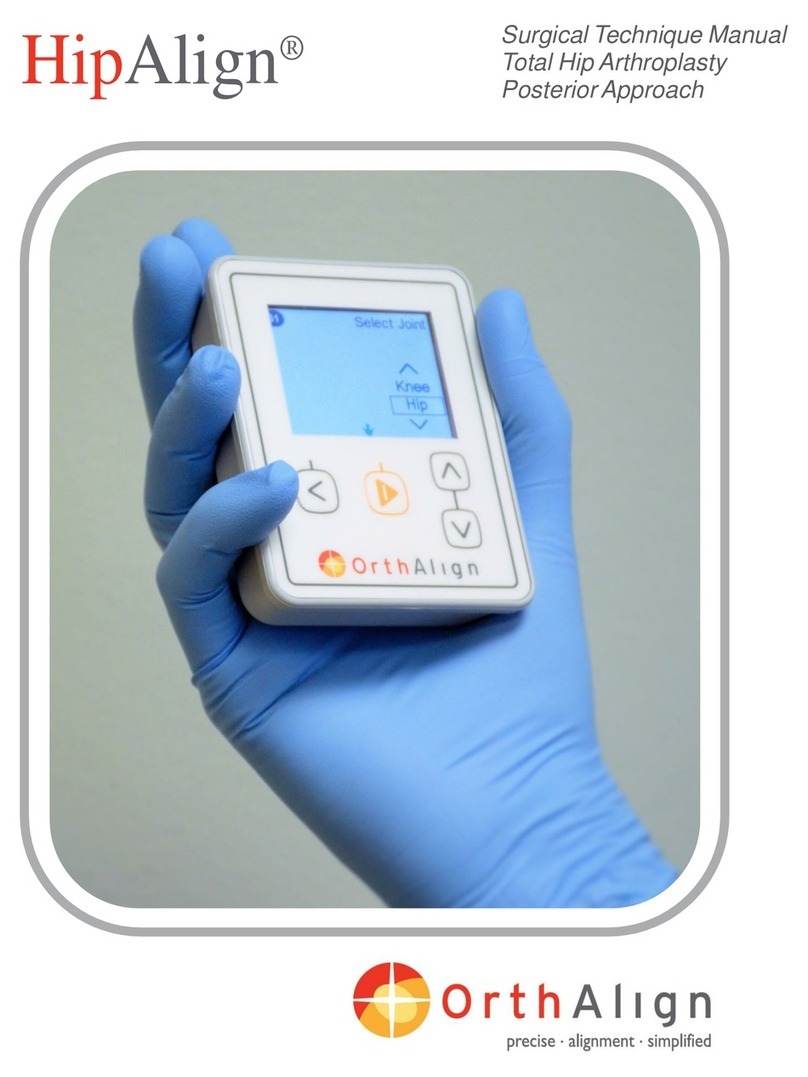
11
KneeAlign®2 System Surgical Technique ManualKneeAlign®2 System Surgical Technique Manual
10
FEMUR FEMUR
Set Resection Plane
• Set desired varus/valgus and flexion/extension angles
using ball driver to adjust microblock’s navigation screws.
• Press center button when completed.
TIP: Navigation unit must be oriented within its operating
range in order for unit to display resection angles.
TIP: Varus/valgus and flexion/extension angles are measured
relative to mechanical axis of femur.
Do not attempt to adjust cutting block orientation by
applying force to jig. Angles must be adjusted using ball
driver to adjust screws prior to pinning the cutting block.
Applying excessive torque to adjustment screws at limit
of travel will cause damage to microblock.
If bone interferes with cutting block while setting resection
angle, microblock has been pinned in too much flexion.
Two alternatives may be considered:
1. Use sagittal saw to trim interfering bone to provide
additional travel for cutting block. Care should be taken
not to remove too much bone, which could cause
notching or interfere with subsequent sizing.
2. Unpin microblock and re-pin closer to neutral flexion
angle, repeating Femur–Steps 1-4.
Set Resection Depth (cont.)
TIP: Resection depth is indicated by scale on anterior face of
guide rod, viewed at top of distal guide. Shoulder on guide
rod stops distal guide at 9 mm resection depth. Resection
depth can be increased in 1 mm increments by squeezing
pushbutton and pulling distal guide up.
Resection depth measurement should be set according
to implant manufacturer’s recommendations.
Resection depth scale is relative to position of distal guide.
Ensure that distal guide paddles remain flush on highest
point of condyle being referenced.
TIP: When pinning the cutting block, take care to avoid
applying excessive force that could alter intended varus/
valgus and flexion/extension angles.
To prevent potential interference of oblique pin with microblock
pins, do not insert oblique pin until microblock has been removed.
Use angel wing stylus to verify resection level prior to resection.
TIP: If more bone needs to be resected, move cutting block
proximally on parallel pins (+2mm, +4mm). Required
saw blade thickness is 1.27 mm (or 0.050 in).
If distal guide contacts condyle before the desired depth
setting is reached, microblock has been pinned in too much
extension. Unpin microblock and re-pin closer to neutral
flexion angle, repeating Femur–Steps 1-4.
Set Resection Depth
• Remove navigation unit/bracket assembly, and sensor
from microblock.
aAttach distal guide to microblock guide rod by
squeezing pushbutton (b), and slide distal guide to
desired resection depth (c).
dPress gold latch on side of microblock to unlock guide
rod/cutting block assembly from its maximum anterior
position. Position distal guide paddles flush against
condyles, and slide cutting block posteriorly to
contact femur.
ePin distal femoral cutting block to anterior femur
using most proximal holes using headless pins
provided in instrument tray.
f Remove pins from microblock by pulling in distal
direction, while securely holding cutting block in place.
Fix cutting block with oblique pin if desired.
gResect distal femur.
• Press center button when completed.
Finished Femur
• Use of navigation unit for distal femoral resection
is finished.
TIP: Press center button to continue if additional
use is appropriate in this procedure.
Step Step
56
F/E
V/V
Resection
Scale Unlock
Removal of navigation
unit from bracket
a
e
d
g
c
f
b
Step Step
6 7




























